Featured Teacher - April
Anna Wofford, Frederick
2019 AITC Teacher of the Year, Early Childhood Education Finalist
Q1.
How did you first learn about the Ag in the Classroom Program?
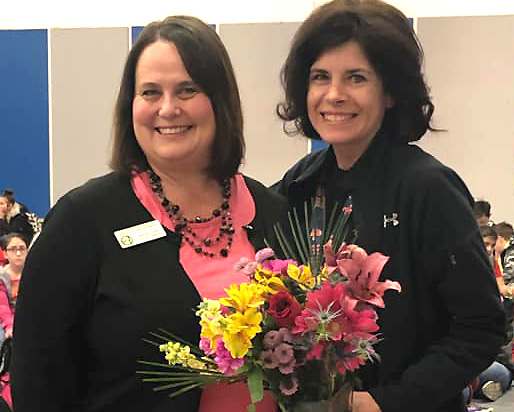 Anna: I first learned about Ag in the Classroom during my lunch break my first year teaching. That small "bite" of AITC wet my "appetite" for the program and I dove right in! I currently teach third grade at Frederick Elementary. After being introduced to AITC, I was amazed at the diverse possibilities I could utilize inside my classroom. I have since attended three AITC training opportunities in the past year. In November, I attended a professional development day training at Frederick Elementary. I also participated in the Farm to School conference located in Stillwater. In July 2018, I participated in the summer AITC conference located in OKC. This opportunity changed the way I wanted to use these lessons inside my classroom. I was able to see how the lesson plans would integrate into every subject I teach on a daily basis.
Anna: I first learned about Ag in the Classroom during my lunch break my first year teaching. That small "bite" of AITC wet my "appetite" for the program and I dove right in! I currently teach third grade at Frederick Elementary. After being introduced to AITC, I was amazed at the diverse possibilities I could utilize inside my classroom. I have since attended three AITC training opportunities in the past year. In November, I attended a professional development day training at Frederick Elementary. I also participated in the Farm to School conference located in Stillwater. In July 2018, I participated in the summer AITC conference located in OKC. This opportunity changed the way I wanted to use these lessons inside my classroom. I was able to see how the lesson plans would integrate into every subject I teach on a daily basis.Q2.
How long have you been using the AITC lessons in your classroom?
Anna: I began teaching in November 2016. That's when I first learned about Ag in the Classroom. I was amazed at the possibility of utilizing AITC lessons in my classroom to share my passion for agriculture with my students.
Q3.
How do you incorporate AITC into your curriculum?
Anna: We have had several cuts to our local school which allows third-grade teachers to have art once a week inside our classroom. I have utilized several art projects inside the classroom such as "Pumpkin Seed Art" using leftover seeds from our modified Pumpkin Facts lesson. Another art project the students enjoyed was using the "Street Cows" to create personalized street cows, along with a writing activity explaining the design he or she chose. Expanding AITC in our art area has allowed the students to create unique art projects. Participating in the AITC poster contest was also a great resource to use with our art class for several weeks. The students were able to learn what agriculture resources are located right here in Oklahoma. It was a wonderful opportunity for me to clarify any misinterpretations. It also let me know where I need to dig deeper and give the students a solid understanding of their rural environment.
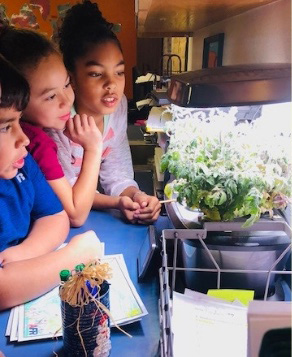 Each month, I highlight a different fruit or vegetable. I bring in fresh vegetables or fruits for the students to taste test. During September of 2017, we began growing green beans with a colleague's Aero Garden right inside our classroom, and the rest is history! AITC came and took a video of my classroom which can be found on YouTube if you search for "Oklahoma Ag in the Classroom: A Bean is a Seed." We recently grew four cherry tomato plants. The students were able to document and journal the progress of their tomatoes. The students were able to use this process to assist in their writing abilities.
Each month, I highlight a different fruit or vegetable. I bring in fresh vegetables or fruits for the students to taste test. During September of 2017, we began growing green beans with a colleague's Aero Garden right inside our classroom, and the rest is history! AITC came and took a video of my classroom which can be found on YouTube if you search for "Oklahoma Ag in the Classroom: A Bean is a Seed." We recently grew four cherry tomato plants. The students were able to document and journal the progress of their tomatoes. The students were able to use this process to assist in their writing abilities.
Utilizing the "Harvest of the Month" to further educate the students on a particular vegetable and fruit has been amazing. The students also get to enjoy a taste testing which allows the lesson to cross into health and wellness because we discuss how the veggie or fruit is right for your body. We have partnered our Harvest of the Month with the "Nutrition and Did you Know?" posters to gain a better understanding visually about their fruit or vegetable.
 Each month, I highlight a different fruit or vegetable. I bring in fresh vegetables or fruits for the students to taste test. During September of 2017, we began growing green beans with a colleague's Aero Garden right inside our classroom, and the rest is history! AITC came and took a video of my classroom which can be found on YouTube if you search for "Oklahoma Ag in the Classroom: A Bean is a Seed." We recently grew four cherry tomato plants. The students were able to document and journal the progress of their tomatoes. The students were able to use this process to assist in their writing abilities.
Each month, I highlight a different fruit or vegetable. I bring in fresh vegetables or fruits for the students to taste test. During September of 2017, we began growing green beans with a colleague's Aero Garden right inside our classroom, and the rest is history! AITC came and took a video of my classroom which can be found on YouTube if you search for "Oklahoma Ag in the Classroom: A Bean is a Seed." We recently grew four cherry tomato plants. The students were able to document and journal the progress of their tomatoes. The students were able to use this process to assist in their writing abilities.Utilizing the "Harvest of the Month" to further educate the students on a particular vegetable and fruit has been amazing. The students also get to enjoy a taste testing which allows the lesson to cross into health and wellness because we discuss how the veggie or fruit is right for your body. We have partnered our Harvest of the Month with the "Nutrition and Did you Know?" posters to gain a better understanding visually about their fruit or vegetable.
Q4.
How has the Oklahoma Pork Council Grant allowed you to implement AITC lessons into your curriculum?
Anna: Last year I was a proud recipient of the Ag in the Classroom/Pork Council grant. I was awarded funds to purchase an Aero Garden of our very own. I was able to purchase a garden along with two types of seed pods to grow this year. In January, we began growing lettuce to feed our classroom pet which is a Sulcata tortoise. The students enjoy journaling about the plants and taste testing the fruits of their labor.
Q5.
What impact has AITC had on your classroom?
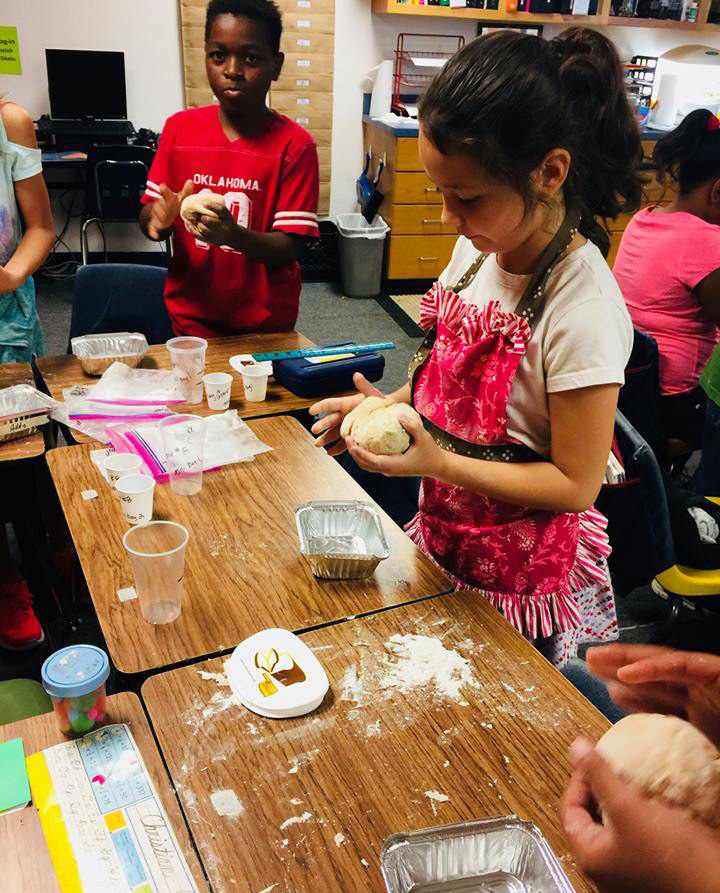 Anna: Using AITC has made an enormous impact on how I teach. Utilizing these lessons and resources allows me to bring the outside farming community right inside my classroom doors. I have a passion for educating my students because I was raised in this rural community with gardens, cattle, pigs, and sheep. I spent the spring, summer, and fall with my hands in the dirt gardening with my parents. Now as an adult I own and operate a seasonal pumpkin patch/corn maze. We also raise cattle, goats, and honey bees. So this is where my passion for agriculture has evolved and continues to inspire me to want to educate my students about the agriculture surrounding them in their local rural area.
Anna: Using AITC has made an enormous impact on how I teach. Utilizing these lessons and resources allows me to bring the outside farming community right inside my classroom doors. I have a passion for educating my students because I was raised in this rural community with gardens, cattle, pigs, and sheep. I spent the spring, summer, and fall with my hands in the dirt gardening with my parents. Now as an adult I own and operate a seasonal pumpkin patch/corn maze. We also raise cattle, goats, and honey bees. So this is where my passion for agriculture has evolved and continues to inspire me to want to educate my students about the agriculture surrounding them in their local rural area.Last year I was inspired by three students who began a small home garden because of their experience with AITC inside my classroom. I want to continue to engage my students with AITC throughout the entire school year. I want to continue to be a lifelong learner, along with my students. Utilizing these exceptional lessons and resources from AITC allows me to teach the Oklahoma Academic Standards to the maximum of my ability. When we focus on growth ourselves, the growth of the entire education system is inevitable, no matter what kind of circumstances surround us to ensure our students will remain a success. "Education is the key to success in life, and teachers make a lasting impact in the lives of their students" (BrainyQuote, 2017, para. 1).
Q6.
How have the AITC lessons impacted your students lives?
Anna: Utilizing AITC has impacted my students lives in more ways than one. Every month I send home a recipe card which I received from the ONIE project at the Farmers Market/Agritourism conference in February. These cards give the family a talking point spotlighting our "Harvest of the Month." I also send out a monthly newsletter to engage my parents.
Inside my classroom, I utilize AITC lesson plans as much as possible. One of our favorites, which has left a positive note in my classroom, was "A Bean is a Seed" lesson where the students learned the sprouting process which takes place under the soil. I modified the lesson by wrapping pinto beans inside a damp paper towel, hung them in the hallway to observe their growth, and had the students journal over a couple of weeks.
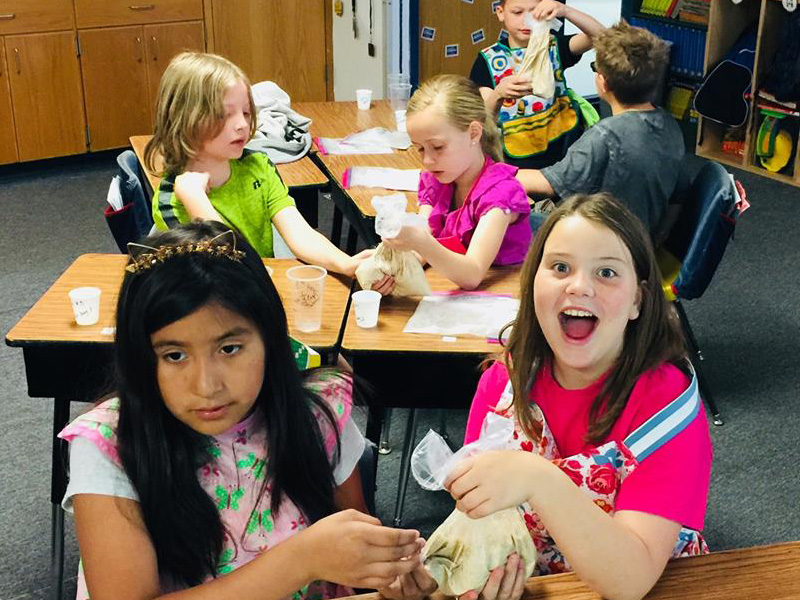 In May of 2017, the students had a week long, in-depth learning, about wheat and the growing process. I used "Wheat Lessons" from AITC to teach this process. I utilized the slide shows and lessons to share the different ways we use wheat in our area. We ended with a hands-on activity by baking their loaves of bread right inside the classroom.
In May of 2017, the students had a week long, in-depth learning, about wheat and the growing process. I used "Wheat Lessons" from AITC to teach this process. I utilized the slide shows and lessons to share the different ways we use wheat in our area. We ended with a hands-on activity by baking their loaves of bread right inside the classroom.
Each year in September, we visit the Tillman County Fair. The students engage by viewing the diversity of animals judged to the perfection of their species. The students also can observe the crops being judged by yields to show their ability to harvest a successful crop. The students each submitted a salt dough map entry, shaped as Oklahoma with landmarks. We utilized the Commodity Map provided by AITC to share what crops are grown in our counties.
I was able to utilize our community extensions in October by taking the students to our local pumpkin patch. The students were able to feed animals, see where and how pumpkins grow, take a hayride, play life-size games, get lost in a corn maze, and carve a classroom pumpkin. The students were amazed by the diverse animals and learning facts about those animals.
In December, the students created an Ag in the Classroom poster to enter into the contest. The theme this year was "Oklahoma Ag Adventure." What better way to show the adventure of ag in Oklahoma than to utilize the Oklahoma Agritourism website and map? After viewing the diverse regions, the students had a better way to create a different ag adventure in Oklahoma.
Inside my classroom, I utilize AITC lesson plans as much as possible. One of our favorites, which has left a positive note in my classroom, was "A Bean is a Seed" lesson where the students learned the sprouting process which takes place under the soil. I modified the lesson by wrapping pinto beans inside a damp paper towel, hung them in the hallway to observe their growth, and had the students journal over a couple of weeks.
 In May of 2017, the students had a week long, in-depth learning, about wheat and the growing process. I used "Wheat Lessons" from AITC to teach this process. I utilized the slide shows and lessons to share the different ways we use wheat in our area. We ended with a hands-on activity by baking their loaves of bread right inside the classroom.
In May of 2017, the students had a week long, in-depth learning, about wheat and the growing process. I used "Wheat Lessons" from AITC to teach this process. I utilized the slide shows and lessons to share the different ways we use wheat in our area. We ended with a hands-on activity by baking their loaves of bread right inside the classroom.Each year in September, we visit the Tillman County Fair. The students engage by viewing the diversity of animals judged to the perfection of their species. The students also can observe the crops being judged by yields to show their ability to harvest a successful crop. The students each submitted a salt dough map entry, shaped as Oklahoma with landmarks. We utilized the Commodity Map provided by AITC to share what crops are grown in our counties.
I was able to utilize our community extensions in October by taking the students to our local pumpkin patch. The students were able to feed animals, see where and how pumpkins grow, take a hayride, play life-size games, get lost in a corn maze, and carve a classroom pumpkin. The students were amazed by the diverse animals and learning facts about those animals.
In December, the students created an Ag in the Classroom poster to enter into the contest. The theme this year was "Oklahoma Ag Adventure." What better way to show the adventure of ag in Oklahoma than to utilize the Oklahoma Agritourism website and map? After viewing the diverse regions, the students had a better way to create a different ag adventure in Oklahoma.
Q7.
What advice do you have for other teachers to use AITC in their classrooms?
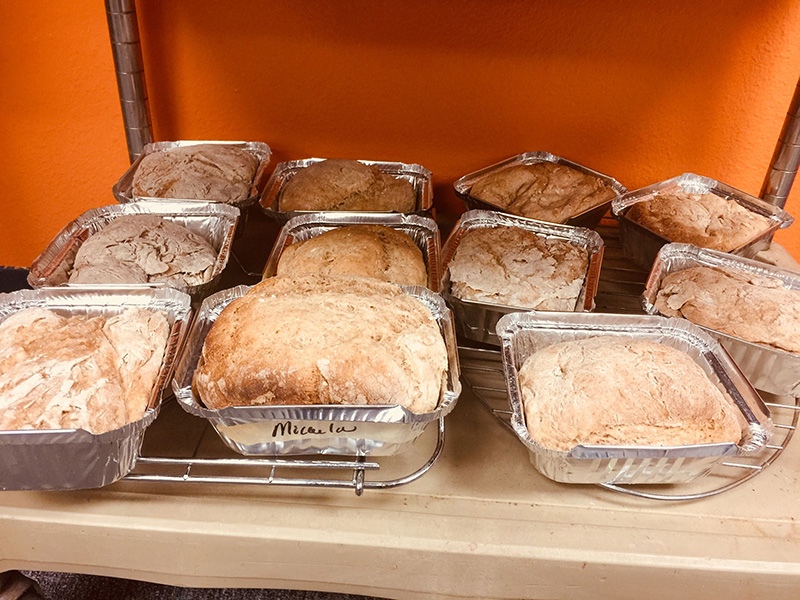 Anna: At the beginning of the school year, things are bustling and scurrying. So getting into the swing of things is a pure challenge. I begin using AITC in September with my Science curriculum. The students are learning the difference between living and non-living things. So what better way to teach them about living things, such as plants, than by sprouting tomatoes (or other plants) inside the classroom? The students like hands-on activities and I think this was one of their favorites.
Anna: At the beginning of the school year, things are bustling and scurrying. So getting into the swing of things is a pure challenge. I begin using AITC in September with my Science curriculum. The students are learning the difference between living and non-living things. So what better way to teach them about living things, such as plants, than by sprouting tomatoes (or other plants) inside the classroom? The students like hands-on activities and I think this was one of their favorites.Also, plan to attend the AITC conference in July! After attending, I was inspired by a veterinarian/author which I had the pleasure of meeting. I was able to set up an author's reading for our 3rd and 4th-grade students. Dr. Harfield came to our school and read one of her books "Pistol" to the students. She also brought Pistol with her which was an added treat. Collaborating with colleagues who have the same passion as you do to teach ag in the classroom is a bonus!
